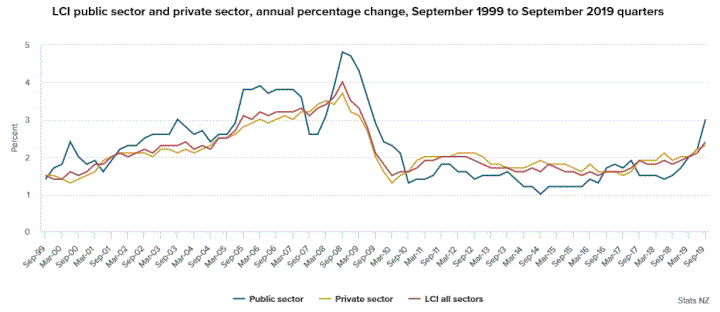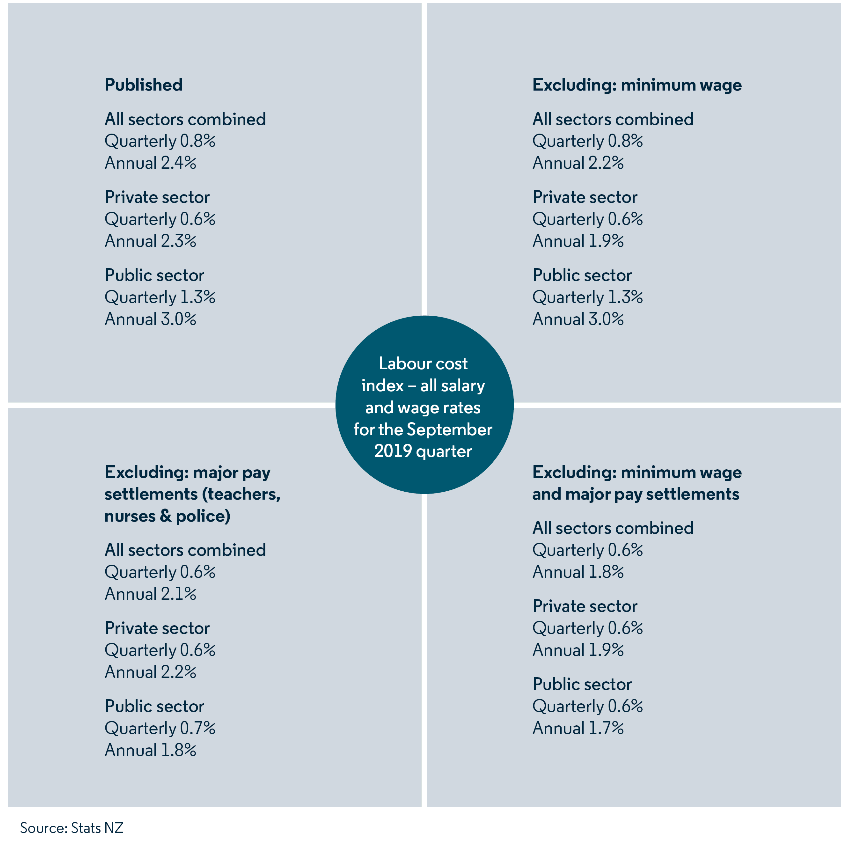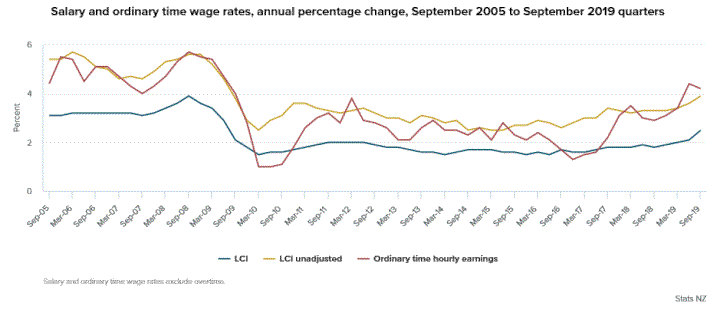Pay settlements help push wage growth to a ten-year high
6 November 2019
Labour cost index (LCI) salary and wage rates (including overtime) increased 2.4 percent in the year to September 2019 quarter, its largest annual increase since the June 2009 quarter, Stats NZ said today.

“Annual wage growth is at its highest level since the 2008 global financial crisis, after which wage growth remained largely flat,” business prices delivery manager Bryan Downes said.
“The percentage of wages that increased is at its highest level since March 2015, at 59 percent. This shows there has been more broad-based wage growth across the LCI.”
Salary and wage rates for the public sector increased 3.0 percent annually, the highest rate since June 2009. This compares to a 2.2 percent increase in the year to the June 2019 quarter.
Public sector wage rates have been driven by collective agreements for teachers, nurses, and police over the past year. With these three largest occupations excluded, public sector wages would have increased 1.8 percent annually.

Text alternative for diagram, Labour cost
index – all salary and wage rates for the September 2019
quarter
Private sector wage rates rose 2.3 percent in the year to September 2019, compared with a 2.2 percent increase in the year to the June 2019 quarter.
“The minimum wage increase last quarter was the largest in percentage terms since 2007 and will continue to boost overall salary and wages,” Mr Downes said.
“The minimum wage will continue to rise in annual increments, reaching $20.00 per hour by 2021.”
The unadjusted LCI for the private sector increased 3.8 percent over the year, while the unadjusted LCI for all salaries and wages increased 3.9 percent annually.
The LCI salary and wage rates measures movements in wages for a fixed quantity and quality of labour. This means that changes in pay rates due to the performance of employees or promotions are not shown in the index.
The unadjusted LCI, on the other hand, takes into account those factors which make it more comparable with the earnings measures in the quarterly employment survey (QES).

In the year to the September 2019 quarter, QES average ordinary time hourly earnings increased by 4.2 percent. The key influences for higher average ordinary time hourly earnings were the professional, scientific, technical, administrative, and support services; health care and social assistance; and public administration industries.
Primary, and secondary teachers’ pay settlements were confirmed in late June. The effect of these pay increases has come through in the LCI, with the education and training industry seeing a 1.7 percent increase in salary and wage rates (including overtime) over the quarter.
Conversely, in the QES, average total hourly earnings in education and training has remained flat this quarter.
This difference between the LCI and the QES, can be explained by the fact that, although teachers’ new salaries had been agreed upon, they had not actually started to be paid out before the mid-August reference dates of the QES and LCI.
While the LCI reports the new agreed-upon salaries, the QES reports on the actual amount of money that has been paid out, which did not yet reflect the new salaries. We can expect to see teachers’ pay increases coming through in the QES in the December 2019 quarter.
Text alternative for diagram, Labour cost index – all salary and wage rates for the September 2019 quarter
Diagram shows the published labour cost index figures for the September 2019 quarter. For all sectors combined, the published quarterly rate was 0.8%, annual rate was 2.4%. For the private sector, the quarterly rate was 0.6%, annual rate was 2.3%. For the public sector, the quarterly rate was 1.3%, annual rate was 3.0%. Excluding minimum wage impact, for all sectors combined, the quarterly rate was 0.8%, annual rate was 2.2%. Private sector quarterly rate was 0.6%, annual was 1.9%. Public sector quarterly rate was 1.3%, annual was 3.0%. Excluding major pay settlements (teachers, nurses & police), for all sectors combined, the quarterly rate was 0.6%, annual was 2.1%. Private sector quarterly rate was 0.6%, annual was 2.2%. Public sector quarterly rate was 0.7%, annual was 1.8%. Excluding minimum wage and major pay settlements, for all sectors combined, the quarterly rate was 0.6%, annual was 1.8%. Private sector quarterly rate was 0.6%, annual was 1.9%. Public sector quarterly rate was 0.6%, annual was 1.7%.
The Government Statistician authorises all statistics and data we publish.
For more
information about these statistics:
• Visit Labour market statistics: September 2019
quarter
• See Unemployment rises to 4.2 percent, while
underutilisation falls
• See CSV files for
download
ends


 Ngā Pae o te Māramatanga: Māori Concerns About Misuse Of Facial Recognition Technology Highlighted In Science
Ngā Pae o te Māramatanga: Māori Concerns About Misuse Of Facial Recognition Technology Highlighted In Science Retail NZ: Retailers Call For Flexibility On Easter Trading Hours
Retail NZ: Retailers Call For Flexibility On Easter Trading Hours WorkSafe NZ: Worker’s Six-Metre Fall Prompts Industry Call-Out
WorkSafe NZ: Worker’s Six-Metre Fall Prompts Industry Call-Out PSGR: Has MBIE Short-Circuited Good Process In Recent Government Reforms?
PSGR: Has MBIE Short-Circuited Good Process In Recent Government Reforms? The Reserve Bank of New Zealand: RBNZ’s Five Year Funding Agreement Published
The Reserve Bank of New Zealand: RBNZ’s Five Year Funding Agreement Published Lodg: Veteran Founders Disrupting Sole-Trader Accounting in NZ
Lodg: Veteran Founders Disrupting Sole-Trader Accounting in NZ



